Adrian Collins's Blog, page 50
July 9, 2024
Gladiator 2 is coming! Here’s the best dark fantasy to read between now and November 14
Last Updated on July 10, 2024
Gladiator starring prime Russel Crowe is one of the best pieces of cinema ever created. I’ve watched that movie–or had it running in the background while working on this very website–so many times I’ve lost count. To actually see the trailer for Gladiator 2 release almost twenty-five years later is both wildly exciting and absolutely terrifying to a super fan, like me. The cinematics, battles, closeness of the one-on-one combat, and Denzel Washington’s character (despite whatever that American slash something accent attempt is) have me pumped for this. The one violently intrusive thought I have is that, other than 2022’s Top Gun: Maverick, I can’t really recall the last time trying to recreate that amazing feeling of the original or taking a new spin on an old movie went well.
Whatever may come, there is the better part of half a year between now and when Gladiator 2 hits the screens, and if you’re anything like me, you’ve got an itch to read about some dark fantasy gladiators getting their feet onto the red sand. The team and I are here to help with that, starting with a book from one of the best series I’ve ever read, The Midnight Falcon by David Gemmell (Rigante quadrilogy) where gladiators Rage and Bane took to the sands for bloody adventure and vengeance.
The Midnight Falcon by David Gemmell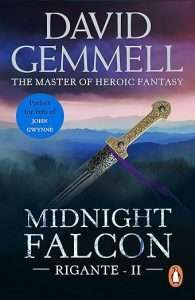 If you’re in the mood for more gladiator combat, you need to drop everything and read Midnight Falcon ASAP. When Bane the Bastard is exiled from his homeland of the Rigante highlands, he sets his sights on Stone—Gemmell’s fantasy version of the Roman Empire. All his plans turn to dust at the tip of Voltan’s blade, Bane sets off on a desperate quest for revenge.
If you’re in the mood for more gladiator combat, you need to drop everything and read Midnight Falcon ASAP. When Bane the Bastard is exiled from his homeland of the Rigante highlands, he sets his sights on Stone—Gemmell’s fantasy version of the Roman Empire. All his plans turn to dust at the tip of Voltan’s blade, Bane sets off on a desperate quest for revenge.
His training to become the best Gladiator in Stone brings him under the tutelage of Rage and Telors, famous gladiators past their prime who are training for one last desperate bout. But his quest to face Voltan in the colluseum leads to more than just one on one combat. Bane finds himself caught incredible ocean of blood as the machinations of the Emperor Jasaray and his enemies as they grapple for power and topple the great army of Stone into war with the Rigante. Incredibly sharp combat scenes, whip-smart political manoeuvring, a desperate war of people defending their home land, and some of the most brilliant character work in the genre will keep you busy while you wait for Gladiator II’s release!
About The bookBane the Bastard is the illegitimate son of the Rigante king who men called Demonblade. Born of treachery, Bane grew up an outcast in his own land, feared by his fellow highlanders, and denied by the father whose unmistakable mark he bore–the eyes of Connavar, one tawny brown, the other emerald green.
Hounded from the country of his birth, Bane found acceptance across the seas–only to have it stripped away in an instant by a cruel and deadly swordsman. Now fighting as a gladiator in the blood-soaked arenas of the Empire, Bane lives for one thing: revenge. And he pursues his goal with the same single-minded determination that won his father a crown.
But more is at stake than a young warrior’s quest for vengeance. The armies of the Stone are preparing to march on the lands of the Rigante. The fate of human and Seidh alike will be decided by the clash of swords–and by the bonds of twisted love and bitterness between a father and a son . . .
Read The Midnight FalconGodsgrave by Jay Kristoff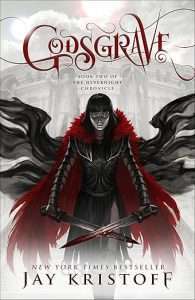 Godsgrave is the second book in Jay Kristoff’s Nevernight trilogy and a must for Gladiator fans. Set in the Republic of Itreya, there are many similarities between Kristoff’s world and ancient Rome – including the gladiator arena and the citizens’ love for blood sports. Assasin Mia Corvere sells herself into slavery for the chance to exact revenge on two of the most powerful men in the land on a rare occasion when they will both appear in public at a gladiator tournament. The only hitch? Mia has to become the champion of the battle royale to get herself close enough to assassinate them.
Godsgrave is the second book in Jay Kristoff’s Nevernight trilogy and a must for Gladiator fans. Set in the Republic of Itreya, there are many similarities between Kristoff’s world and ancient Rome – including the gladiator arena and the citizens’ love for blood sports. Assasin Mia Corvere sells herself into slavery for the chance to exact revenge on two of the most powerful men in the land on a rare occasion when they will both appear in public at a gladiator tournament. The only hitch? Mia has to become the champion of the battle royale to get herself close enough to assassinate them.
The reader gets to witness Mia’s time training rigorously in the gladiator collegium, form relationships with her fellow gladiators (some friendly, some not), and perform in the arena. There are numerous fast paced gladiator battles described by Kristoff in all the bloody gory detail imaginable. The gladiators are mostly new characters to the series and Kristoff spends time to build them up, giving back stories and tales of their lives before slavery giving the reader greater insight in to this world. As the second book in the trilogy it isn’t the best starting point, but gladiator Mia is just as entertaining as assasin Mia and is must read for those who want more blood stained sands in their reading material.
Read our review here.
About the bookThe second thrilling installment of the award-winning Nevernight Chronicle, from New York Times bestselling author Jay Kristoff.
In a land where three suns almost never set, a ruthless assassin continues her quest for vengeance against the powers who destroyed her family.
Mia Corvere has found her place among the Blades of Our Lady of Blessed Murder, but many in the Red Church hierarchy think she’s far from earned it. Plying her bloody trade in a backwater of the Republic, she’s no closer to ending the men who destroyed her familia; in fact, she’s told directly that Consul Scaeva is off limits. But after a deadly confrontation with an old enemy, Mia’s suspicions about the Red Church’s true motives begin to grow.
When it’s announced that Scaeva will be making a rare public appearance at the conclusion of the grand games in Godsgrave, Mia defies the Church and sells herself to a gladiatorial collegium for a chance to finally end him. Upon the sands of the arena, Mia finds new allies, bitter rivals, and more questions about her strange affinity for the shadows. But as conspiracies unfold within the collegium walls, and the body count rises, Mia will be forced to choose between love and revenge, and uncover a secret that could change the very face of her world.
Read Godsgrave by Jay KristoffBuzzard’s Bowl by John Palladino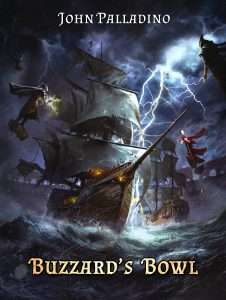 Buzzard’s Bowl, the second volume of John Palladino’s grimdark fantasy series, The Tragedy of Cedain, features plenty of gladiator action. Edelbrock Brendis is a former minor nobleman who, through his own strategic missteps, becomes an enslaved gladiator fighting in the Buzzard’s Bowl arena. Edelbrock is a deeply pathetic and tragic figure, drawing equal parts sympathy and repugnance, but he grows significantly throughout Buzzard’s Bowl while oscillating between depth and shallowness of character.
Buzzard’s Bowl, the second volume of John Palladino’s grimdark fantasy series, The Tragedy of Cedain, features plenty of gladiator action. Edelbrock Brendis is a former minor nobleman who, through his own strategic missteps, becomes an enslaved gladiator fighting in the Buzzard’s Bowl arena. Edelbrock is a deeply pathetic and tragic figure, drawing equal parts sympathy and repugnance, but he grows significantly throughout Buzzard’s Bowl while oscillating between depth and shallowness of character.
Buzzard’s Bowl is full of fast-paced action with plenty of surprises for each of the main characters, especially when their storylines converge. Palladino shines in writing pulse-pounding action sequences. My favorite is the scene captured on the outstanding cover designed by Dusan Markovic, which depicts a flooded Buzzard’s Bowl arena with battling gladiator ships electrified by levitating Magicai wizards. This is one of several epic action sequences in the book that grimdark fans will adore.
Read our review here.
About the bookCedain continues to collapse.
Ashmount’s destruction shatters the Magicai while the culprits responsible continue sabotaging the world. All the while, the next season of Buzzard’s Bowl begins and Edelbrock, in his constant fight for survival, desires a vengeance he can only find in the arena.
Seradal and Villic find themselves in the middle of a war between Remeria and the Camel Clans, and may end up on opposing sides, while the threat of Calrym looms over all of them.
At the behest of the woman he loves, Demri finds himself thrown into the Elkavich, a not-so-secret order of Magicai who are intent upon fixing the world.
Ashen, a former urchin rescued by a noble with selfish aspirations, works to dismantle the nobility of Calrym.
Death is assured to all who walk the world, the only unknown is when they will perish.
Read Buzzard’s Bowl by John PalladinoThe post Gladiator 2 is coming! Here’s the best dark fantasy to read between now and November 14 appeared first on Grimdark Magazine.
July 8, 2024
REVIEW: Unexploded Remnants by Elaine Gallagher
Unexploded Remnants is the debut novella by Scottish author Elaine Gallagher and tells the story of Alice, who is the last surviving human and spends her time seeking out unusual artefacts for preservation and/or safety. One such rummage throws up an artefact that looks like a lava lamp—the book is full of 20/21st century references—but is in fact an AI soldier from a long-ago war. This of course leads to a breathless chase across the galaxy to find the entity (taking the name of “Gunn”) a safe and ethical outcome while dubious forces seek to obtain it and dispose of Alice as collateral.
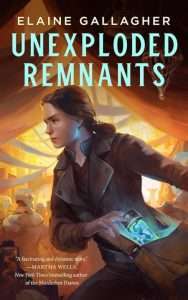 Imagine a queer Indiana Jones/Tomb Raider story that sprawls through a diverse universe reminiscent of both Star Wars and the Culture, with added Stargate and Doctor Who elements. Unexploded Remnants is a wild ride that starts off a top speed and rarely lets up.
Imagine a queer Indiana Jones/Tomb Raider story that sprawls through a diverse universe reminiscent of both Star Wars and the Culture, with added Stargate and Doctor Who elements. Unexploded Remnants is a wild ride that starts off a top speed and rarely lets up.
That worldbuilding is a key part of Unexploded Remnants as Gallagher offers a glimpse into a galaxy where anything seems possible and proceeds at a brisk pace from the kind of market you’d expect on Tatooine through salvage yards, overwhelming cyberpunk vistas and a more sedate city just in the opening sequence. There are hints of a vibrant, exciting universe begging to be explored in more detail and I really want to see it.
Alice’s backstory is similarly fascinating, but not overly dwelt upon. She’s a trans woman who fell upon the portal network one day and ended up as a freelancer for ‘the Archive’ and was thus saved from Earth’s resulting climate collapse, becoming the last human. Those themes of queer representation, being the last of your kind and trying to make your way when out of time and place are integral to the story, especially those points of empathy between Alice and Gunn.
One line that stuck out to me was during Alice and Gunn’s initial conversation where Gunn replies “You count me as ‘people,’ then?” That’s the key element of the story and couldn’t be a more apt theme for these times.
While somewhat outside the usual grimdark vein, I feel that Unexploded Remnants will be a good book for fans of the gritty and morally grey to pick up. Alice’s job as a freelancer picking up antiquities is inherently grey and this universe is far from noblebright or possessing a black and white morality between factions. Furthermore, the key plot points of who counts as people, free will and making hard decisions are at the heart of the grimdark, even if the story isn’t rubbing our nose in mud, blood and swearing.
All in all, this novella is great fun, both thought provoking, action packed and rattles along at a brisk pace with evocative writing that offers plenty of description but doesn’t linger overly on exposition. If I had a criticism it’s that Unexploded Remnants left me wanting more. Like so much in recent years from Murderbot to This is How You Lose the Time War, the novella format is great at giving a digestible amount of science fiction for busy modern lives, but so often leave you wishing for more and Unexploded Remnants is no different. More please.
Read Unexploded Remnants by Elaine GallagherThe post REVIEW: Unexploded Remnants by Elaine Gallagher appeared first on Grimdark Magazine.
July 7, 2024
REVIEW: The Mercy of Gods by James S.A. Corey
When you read a James S.A. Corey novel, you expect sprawling imagination, characters that command your attention, seamlessly woven science and science fiction, and an absolutely barnstorming story. The Mercy of Gods is no different, bringing all of these storyteller skills to play, while also providing a markedly different experience from The Expanse.
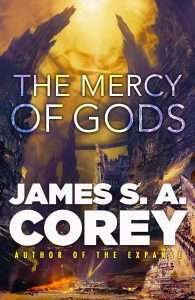 In The Mercy of Gods, we follow a group of team members as they drive their careers as part of the bleeding edge of scientific research industry. They chase funding, protect their research from other teams, and politic their way around trying to find out who is trying to break their team up. Their work is all consuming, the only thing they really care about, until one of them accidentally discovers cloaked ships in the local space around their planet. All of a sudden, which faction is trying to break their team up and take over their research is the most insignificant problem they, or humanity, will ever face. The Carryx are here, and compared to humanity, they are gods.
In The Mercy of Gods, we follow a group of team members as they drive their careers as part of the bleeding edge of scientific research industry. They chase funding, protect their research from other teams, and politic their way around trying to find out who is trying to break their team up. Their work is all consuming, the only thing they really care about, until one of them accidentally discovers cloaked ships in the local space around their planet. All of a sudden, which faction is trying to break their team up and take over their research is the most insignificant problem they, or humanity, will ever face. The Carryx are here, and compared to humanity, they are gods.
As the Carryx take over the planet with brutal force and then steal humanity’s best and brightest, The Mercy of Gods is told through a range of human and alien perspectives. Tonner Freis is the scientific genius leader trying to hold his team and his research together. Else is his right hand person in the field, and partner personally. Daffyd is the most junior, whose aunt happens to be the head of the funding committee, and finds opportunity to step out from obscurity. Jessyn is running out of medication as the team are shipped to another galaxy entirely. Campar and the rest of the team and desperately trying to hold themselves together.
The Carryx, a multi-galaxy-dominant alien species who view every other species as a tool that needs sharpening to usefulness as so well done. They feel truly alien, properly removed from humanity, and so far further advanced compared to us that we aren’t even like children to them, we are a branch on a tree, waiting to be cut off and sanded into a tool. I love the snippets of POV from the human’s Carryx librarian (a character who shepherds them to make scientific breakthroughs), providing brilliant excerpts of the vast Carryx empire, their vast war against an enemy we aren’t given much of an insight into, and how the humans are viewed.
Finally, we get to one of my favourite characters, the swarm. The swarm is amongst the humans, taking control of their bodies and minds, one crushed person at a time. The swarm notes all the Carryx do, and waits for the opportunity to report back to its hive mind all it discovers about its species’ greatest foe in the hope of influencing the war against the Carryx.
With all the human and alien POVs, it can sometimes take a moment to orient yourself at the start of a chapter or section, but I think the authors did well to differentiate the characters for the most part. If you are a stern adherent to a single POV style of storytelling, this book is going to be a struggle for you.
The Mercy of Gods is story of resistance in the face of insurmountable odds. Of what people might do when the universe crushes them beneath its vicious heel. Of science, and mystery, wonder, terror, and perspective of horror. Of what it feels like to be an ant or an animal, and your life to be worth only what you can produce for a more powerful species. I’d say it’s a nice play on the story of what it’s like to be anything other than a human being, in our real life world.
From the perspective of what a grimdark fan will enjoy, you’re going to find a lot of brutality, and a lot of characters reaching down into their souls to find out who they are in the face of adversity. I really enjoyed that aspect. I also loved the the two alien POVs, but I’m always here for the grey moralities of humanity, and I don’t think you’ll find a lot of that in the main perspectives of this story. In some of the side characters you’ll find it in spades, however, and those are worth delving in to.
I think The Mercy of Gods is going to be a book that splits fans of the authors’ previous work, The Expanse. Some I think will love the retention of scientific detail and intellectual focus, of wonder and the unknown becoming horrifically known. Others will decry the loss of sprawling human factions and raging space battles, of political manouvring and that Game of Thrones in space feeling. I, for one, think that’s okay. I quite enjoyed Corey spreading their wings and really showing their creative range, and I can’t wait to pick up book two.
Read The Mercy of Gods by James S.A. Corey Read on Amazon
Read on AmazonThe post REVIEW: The Mercy of Gods by James S.A. Corey appeared first on Grimdark Magazine.
July 6, 2024
REVIEW: Cult of the Spider Queen by S.A. Sidor
Cult of the Spider Queen by S.A. Sidor is the second of the “Andy Van Notwick” trilogy that loosely follows the adventures of said cub reporter as he becomes further and further immersed in the supernatural shenanigans of Arkham, Massachusetts. He was barely a character in the first book, The Last Ritual, but takes center stage in this volume. Andy is an interesting contrast to the Countess Zorzi because he’s a Jimmy Olsen-esque type who is absolutely in over his head with the supernatural.
 The premise for this book is that it takes our hero out of Arkham and brings him to the Amazon rain forest. Andy manages to hijack a package sent to his employers which turns out to be a film reel from a “lost expedition” hosted by a beautiful film starlet turned documentarian, Maude Brion. Engaging in some slight fraud on the basis of hunting “the big scoop”, Andy manages to get together an expedition including Ursula Downs (the resident Lara Croft stand-in of Arkham Horror), her sidekick/possible love interest Jake Williams, and disgraced anthropologist Iris Benett Reed. Also, enough money from a gold magnate to go searching for said expedition (as well as the rumors of a gold mine).
The premise for this book is that it takes our hero out of Arkham and brings him to the Amazon rain forest. Andy manages to hijack a package sent to his employers which turns out to be a film reel from a “lost expedition” hosted by a beautiful film starlet turned documentarian, Maude Brion. Engaging in some slight fraud on the basis of hunting “the big scoop”, Andy manages to get together an expedition including Ursula Downs (the resident Lara Croft stand-in of Arkham Horror), her sidekick/possible love interest Jake Williams, and disgraced anthropologist Iris Benett Reed. Also, enough money from a gold magnate to go searching for said expedition (as well as the rumors of a gold mine).
This isn’t really a very Lovecraftian story even though it involves the Dreamlands and has guest appearances by several Cthulhu Mythos creatures like the Men of Leng, ghouls, and gugs. It’s more of an Indiana Jones, Uncharted, or Tomb Raider-esque story. Which is fine because those are based on the older Allan Quartermain and Tarzan-esque stories that are period appropriate journeys for the 1920s. A bunch of white people head out into the jungle and find themselves facing things only a couple of them have any chance of surviving.
The book avoids a lot of the more unfortunate tropes of this kind of novel by the fact that the “weird cultists in the woods” are descendants of white people who used to run the local rubber plantation and their deranged colonialist leader. This isn’t a spoiler as it’s revealed in the original film reel that sends Andy on his quest. Andy just doesn’t bother to think about this when he’s focused on finding a giant spider to make himself famous.
I really enjoyed the characters of this book aside from, ironically, Andy Van Notwick. Ursula Downs is Lara Croft as I wish she’d be in the games, with a lot more focus on the nuts and bolts of adventuring as well as the realistic issues of archaeology. Jake Williams is a two-fisted man’s man who doesn’t have any problem working under Ursula or feels threatened by her. I even liked Iris Reed despite the fact she’s clearly not playing with a full deck early on. Indeed, the elusive Maude Brion is a fascinating character when we find out more about her.
The few native characters we meet mostly fill the role of, “This is incredibly stupid. Why are you going to this forbidden place that we have forbidden for a very good reason?” Which isn’t great representation but not offensive stereotyping either. Basically, the book just wants to tell an enjoyable adventure story and for the most part it succeeds.
Still, those looking for creeping Lovecraftian horror versus the pulpy combination of such with adventure that Arkham Horror specializes in will probably have to look elsewhere. Its finger is heavily on the scale of the “pulp” side of things. It’s a great novel, don’t get me wrong but it feels a lot more conventional. Adding some more characters to meet horrible demises or using a more traditional Great Old One than the Spider Queen (or revealing her to be the Spawn of Shub-Niggurath) might have been better.
Read Cult of the Spider Queen by S.A. SidorThe post REVIEW: Cult of the Spider Queen by S.A. Sidor appeared first on Grimdark Magazine.
July 5, 2024
REVIEW: The Hidden Queen by Peter V. Brett
The Hidden Queen by Peter V. Brett
The Hidden Queen is the second instalment in Peter V. Brett’s epic fantasy series, The Nightfall Saga, was released in March 2024. I picked up The Hidden Queen immediately after reading the first book in the series, The Desert Prince, which I was thoroughly impressed with. When picking up The Hidden Queen, I was almost sure I would enjoy it, and I did enjoy it immensely. Brett’s captivating writing is the sort of great fantasy we should all be able to find pleasure in. If epic fantasy series are your thing, you will enjoy your time reading Brett’s work. Before reading The Hidden Queen, you must have already read The Desert Prince, but you do not have to know about Brett’s Demon Cycle series, which is set in the same world. Although they complement each other very well, the two series are separate, and the earlier do not need to have been read as a foundation for the latter.
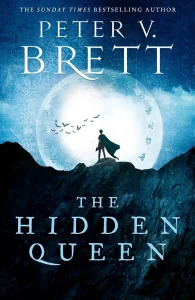 As with the earlier book, The Hidden Queen has two perspectives we follow throughout: Olive Paper and Darin Bales. Uniquely skilled, both are essential in the second war with demonkind – no matter how reluctant they may be to follow in their parents’ footsteps. Finally free of the rigid expectations of being the daughter of the Duchess of Paper, Olive finds that it is no easier to be the son of Ahmann Jardir. Olive does not want to be either or and must navigate both sides of their nature while being part of the front lines of the most crucial battle of a generation. Only an heir of Kaji can wield the magics needed to protect the world, and with both of Olive’s parents still missing, there is no choice but to try. Darin still seems less than everyone, and he knows it. He feels it every moment and is often overwhelmed by the world around him. How can he be helpful to an army when he cannot even cope with a festival crowd? But Darin loves strongly in his own way, and he will face even the demon king to protect those he loves.
As with the earlier book, The Hidden Queen has two perspectives we follow throughout: Olive Paper and Darin Bales. Uniquely skilled, both are essential in the second war with demonkind – no matter how reluctant they may be to follow in their parents’ footsteps. Finally free of the rigid expectations of being the daughter of the Duchess of Paper, Olive finds that it is no easier to be the son of Ahmann Jardir. Olive does not want to be either or and must navigate both sides of their nature while being part of the front lines of the most crucial battle of a generation. Only an heir of Kaji can wield the magics needed to protect the world, and with both of Olive’s parents still missing, there is no choice but to try. Darin still seems less than everyone, and he knows it. He feels it every moment and is often overwhelmed by the world around him. How can he be helpful to an army when he cannot even cope with a festival crowd? But Darin loves strongly in his own way, and he will face even the demon king to protect those he loves.
In my earlier review of The Desert Prince, I wished the perspectives between Olive and Darin had been more evenly split – I immensely enjoyed Darin’s chapters and wanted to see as much of him as I did Olive. I do not have the same complaint about The Hidden Queen. As The Desert Prince was Olive’s story, The Hidden Queen is Darin’s. This book is where he deservedly gets more of the attention. Darin feels like the group’s underdog; his supernatural skills are best suited to slinking around unseen rather than leading a vanguard or raising an army. Darin is probably my favourite character in the series because of this. His resilience and constant overcoming of smaller challenges show his strength differently from those characters who are more conventionally strong. I also loved how Brett does not forget the young age of Olive, Darin, and their friends. They may be trying to save the world, but Olive still yearns to make their parents proud, and Darin has some very socially awkward moments at which one cannot help but smile, even when they have more pressing issues to deal with.
As has been said before, Brett’s writing is not typically grimdark. But there is a lot in the Nightfall Saga to appeal to those who enjoy darker fantasy. This series is a brilliantly written epic fantasy. It has many dark moments, but there is hope and humour throughout it. The small and large battle scenes are very well written and easy to visualise, which I enjoy when reading. Also, and this is a thought that I have been mulling over since reading the first novel, Brett continues to handle potential hot-button topics with great sensitivity and without any character feeling like a token inclusion. I think he has put a lot of care into creating believable and whole characters, and it is just a part of that character that they are, using Olive and Darin as examples, intersex or neurodivergent. His characters are the beating heart of this series, and Brett has made me care for them deeply.
In conclusion, if excellent epic fantasy is your thing, then you will be satisfied by The Hidden Queen. Thank you very much to Peter V. Brett and the team at Harper Voyager, who sent us an advanced reader copy of the novel to review.
Read The Hidden Queen by Peter V. BrettThe post REVIEW: The Hidden Queen by Peter V. Brett appeared first on Grimdark Magazine.
July 4, 2024
REVIEW: Queen B by Juno Dawson
With the Her Majesty’s Royal Coven series, Juno Dawson has created an incisive contemporary look at womanhood, power and perspectives on feminism. These are books that speak to the political issues and conversations that are dominating the discourse here in the UK. Queen B takes a step back from that and is set in the sixteenth century – looking at Anne Boleyn and the first coven. It’s a fairly short novella and a very different vibe to the first two (full-length) novels in the series, Her Majesty’s Royal Coven and The Shadow Cabinet. The themes of sisterhood, jealousy and living outside the social norms continue in Queen B, though the conflicts are far more mundane and personal here.
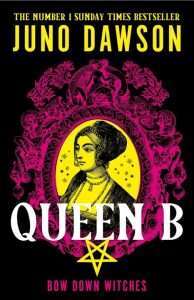 Queen B’s story is told in two timelines. One set in 1536, beginning shortly after Anne Boleyn’s execution. The other is less linear, choosing very specific memories of the (recent) past to show the reader. This gives us an excellent grasp of the characters. The focus is clearly laid on the establishing of characters and relationships, and the story is more feelings and big emotions rather than a strong plot. I found Dawson’s approach to showing the reader very effective. She uses her past storyline to hone in on interpersonal relationships, on why the reader should care about the present story. Giving the reader the space to feel who these characters are and why they do the things they do makes Queen B shine.
Queen B’s story is told in two timelines. One set in 1536, beginning shortly after Anne Boleyn’s execution. The other is less linear, choosing very specific memories of the (recent) past to show the reader. This gives us an excellent grasp of the characters. The focus is clearly laid on the establishing of characters and relationships, and the story is more feelings and big emotions rather than a strong plot. I found Dawson’s approach to showing the reader very effective. She uses her past storyline to hone in on interpersonal relationships, on why the reader should care about the present story. Giving the reader the space to feel who these characters are and why they do the things they do makes Queen B shine.
It was interesting to read a story that, on the face of it, is about someone absent. It reminded me of the first season of Veronica Mars (am I dating myself? Yes.) where Lily, the murdered friend is at the centre of events even though she herself is no longer there. I love when authors play with perspective and unreliable narrators. My gripe with Queen B boils down to wanting more. More nuance, more detail, more time. It works well for what it is, but it didn’t manage to get me thinking the way Her Majesty’s Royal Coven and The Shadow Cabinet did. I still enjoyed my reading experience though, and am looking forward to the next full-length instalment.
Read Queen B by Juno DawsonThe post REVIEW: Queen B by Juno Dawson appeared first on Grimdark Magazine.
July 3, 2024
REVIEW: The Sky on Fire by Jenn Lyons
After the blazing success of her epic A Chorus of Dragons series, Jenn Lyons is now back with another delightfully queer dragon adventure in The Sky on Fire. Set in a richly imagined world ruled by moody dragon overlords, this brand-new standalone is a flaming fun take on a heist fantasy!
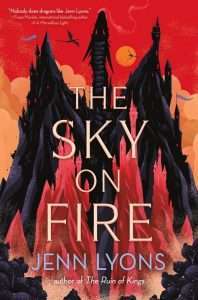 The Sky on Fire opens with one hell of an intriguing prologue which immediately sets the stakes and reassures the reader that: yes, here there do indeed be dragons, and they have dark demands about a certain previously believed dead woman. Enter Anahrod, our wayward protagonist with animal communion skills who has quietly been surviving in the murky jungles of The Deep for the past seventeen years. When a motley crew of morally grey misfits saves her from capture by the local warlord, she realises that the time of running from her past has come to an end. Against her will, she is whisked back to the deceptively lustrous cloud cities and conscripted into their schemes to rob the most powerful dragon’s hoard: a dragon that wants Anahrod dead.
The Sky on Fire opens with one hell of an intriguing prologue which immediately sets the stakes and reassures the reader that: yes, here there do indeed be dragons, and they have dark demands about a certain previously believed dead woman. Enter Anahrod, our wayward protagonist with animal communion skills who has quietly been surviving in the murky jungles of The Deep for the past seventeen years. When a motley crew of morally grey misfits saves her from capture by the local warlord, she realises that the time of running from her past has come to an end. Against her will, she is whisked back to the deceptively lustrous cloud cities and conscripted into their schemes to rob the most powerful dragon’s hoard: a dragon that wants Anahrod dead.
Look, with the ambitiously epic A Chorus of Dragons being one of my all-time favourites, I was nervously excited to see what Lyons could deliver in a contained standalone. And honestly, while this story is not nearly as complex as her previous series, Lyons’ wild imagination and quintessentially quirky storytelling is still on full display in The Sky on Fire.
A divided society ruled by tyrannical dragons with all kinds of unique magical powers, an religion based on humans being thrown out of heaven to serve the dragons, a twisted history written by the victors, and an extremely nuanced and refreshing take on the familiar dragonrider trope which explores consent, co-dependency and power in terrifyingly fascinating ways; how there is so much rich world building packed into such a fast-paced standalone is truly beyond me, but I was gobbling it all up!
Not to mention, Lyons has once again crafted a casually queer-normative world full of beautifully diverse characters who are embraced just the way they are. I especially loved the concept of people expressing their gender, sexuality, and bedroom preferences through wearing different types of rings; we should do ourselves a favour and steal this idea to make dating infinitely easier.
All that said, I personally would not have minded if the pacing had slowed down a bit to let us fully appreciate all these amazing concepts in their full glory. The Sky on Fire zooms along at breakneck speed, and there is truly not a single dull moment to be found. On the one hand, I really liked the utterly addictive ‘just one more chapter’ quality, but on the other hand I found it a bit exhausting that neither the characters nor the reader gets any time to just sit, breathe, reflect, and process for a while.
Don’t get me wrong, I think Lyons has a true knack for creating vibrant, quirky and distinct characters whose clasing identities and motivations make for a very fun dynamic. Yet I also have to admit that I never felt overly invested in any of the characters here, as I barely got any time to get connected to them. Moreover, while I loved the little teases of a beautifully queer poly romance here, I personally think that relationship deserved a lot more development; the feels just weren’t feeling.
Ultimately, the fun factor and highly engaging storytelling made up for some of these quibbles for me, and there’s no denying that Lyons delivered an impressively ambitious standalone story here. True, some of the plot beats and resolutions might have felt a bit overly convoluted or suspiciously convenient, but I think Lyons gets away with it by delivering a story that is just so refreshingly unconventional and inventive in every other way.
If you liked the dragonrider bond in Yarros’ Fourth Wing or Novik’s Temeraire, but also want some heisty action and queer goodness like in M.J. Kuhn’s Thieves duology, then you better try The Sky on Fire. Filled with loveable anti heroes, complicated family drama, brutal beasties, immersive settings, exhilaration action, and a dash of queer love, this fast-paced and action-packed fantasy heist is a smoking hot adventure from start to finish.
Thank you to Tor for providing me with an eARC in exchange for an honest review. All opinions are my own. The Sky on Fire is scheduled for release on July 9, 2024.
Read The Sky on Fire by Jenn LyonsThe post REVIEW: The Sky on Fire by Jenn Lyons appeared first on Grimdark Magazine.
July 2, 2024
REVIEW: Dreams of Sorrow by Shauna Lawless
Dreams of Sorrow is the second novella from author Shauna Lawless. Set in her Gael Song world, it is a powerful piece of short fiction and will be hugely enjoyed by fans of her writing. Chronologically, Dreams of Sorrows takes place before the events of the Gael Song novels, but it should not be a new reader’s first venture into this world. If you have not yet read Lawless’ books, The Children of Gods and Fighting Men and The Words of Kings and Prophets, you must do so before reading this novella, or you risk spoiling certain key plot elements for yourself.
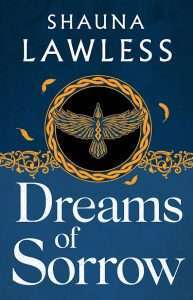 Set in medieval Ireland, Dreams of Sorrow is the short but heart breaking tale of Senna. Senna is fifteen, in love, and content with how her life will be. Until, out of fear, she unwittingly performs magic and discovers she is a witch – a Descendant of the mythical Tuatha dé Danaan. Senna flees from the only home she has ever known and seeks protection and education from other Descendants – kind elderly Anaile, his charismatic son Tomas, and a fellow witch Gobnat. But there are consequences to leaving her mortal life for her magical one. Senna is faced with a choice to make which will shape her life in a way she never could have predicted.
Set in medieval Ireland, Dreams of Sorrow is the short but heart breaking tale of Senna. Senna is fifteen, in love, and content with how her life will be. Until, out of fear, she unwittingly performs magic and discovers she is a witch – a Descendant of the mythical Tuatha dé Danaan. Senna flees from the only home she has ever known and seeks protection and education from other Descendants – kind elderly Anaile, his charismatic son Tomas, and a fellow witch Gobnat. But there are consequences to leaving her mortal life for her magical one. Senna is faced with a choice to make which will shape her life in a way she never could have predicted.
In my review of Lawless’ other novella, Dreams of Fire, I made a similar point: it takes a highly skilled author to pack such an emotional punch into their short fiction. Well, Lawless has done it again. I know and love this world; I knew who almost all the characters were before I began, but I have gained a greater understanding of those who appeared here. Reading Dreams of Sorrow has exponentially increased all the feelings of rage and sorrow that I felt on Senna’s behalf at the end of The Words of Kings and Prophets.
At only one hundred pages, Dreams of Sorrows is a swift read, but after reading I am left with many swirling emotions. I feel more than just a tremendous amount of sympathy for Senna, and what is stolen from her, but also there are characters I did not think it was possible to dislike more, and yet now I do. This novella has the same beautiful style as Lawless’ other works but it is a sharper story with the plot spanning only a few days. Dreams of Sorrow is a literary amuse-bouche before we return to the next full-length novel in the Gael Song series.
I love Lawless’ female-focused fantasy and immensely enjoyed learning more about a character that we have known very little about thus far. I hope that Senna plays a more significant role as the series concludes. In terms of darker elements for grimdark fans, there is not much in the novella due to its length, but if you judge it in terms of the series as a whole, I believe that there is a lot of appeal. Luckily for me, the final novel in the series, The Land of the Living and the Dead, is out in September 2024, so I only have a short time left to wait. I want to thank Shauna Lawless and the team at Head of Zeus / Ad Astra for sending me an eARC of Dreams of Sorrow for review.
Read Dreams of Sorrow by Shauna LawlessThe post REVIEW: Dreams of Sorrow by Shauna Lawless appeared first on Grimdark Magazine.
July 1, 2024
REVIEW: The Night Ends with Fire by K. X. Song
In The Night Ends with Fire, K. X. Song’s dark adult fantasy debut, inspired by the legend of Mulan, Hai Meilin takes control of her destiny. In an attempt to escape her opium-ridden and abusive father, as well as the arranged marriage forced upon her with an equally abusive nobleman, she takes matters into her own hands and enlists for the war under the guise of her father’s ‘bastard son’. Upon enlisting, Meilin finds her stride. While keeping her secret is a source of constant anxiety, she flourishes without the restrictions previously forced upon her. She develops friendships and camaraderie amongst her platoon, a budding infatuation with her commander and training partner Prince Sky and later, a complicated bond with an enemy Prince. As the war of the Three Kingdoms edges closer, so do the voices in her head. Meilin is confronted by Qinglong, a sea dragon spirit connected to the jade necklace her late mother had left for her. Through dreams, visions and hallucinations, Qinglong offers Meilin unending power – but at what cost?
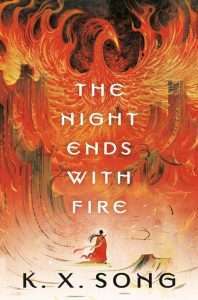 Meilin’s story begins similar to many female fantasy protagonists – put in a situation that essentially causes them to snap and take matters into their own hands. As the story progresses, so does her character. In assuming the role of Hai Ren, she does not abandon her femininity, but instead embraces the parts of her that were suppressed by the men around her; her rage, her ability to fight, and her want for power. She says,
Meilin’s story begins similar to many female fantasy protagonists – put in a situation that essentially causes them to snap and take matters into their own hands. As the story progresses, so does her character. In assuming the role of Hai Ren, she does not abandon her femininity, but instead embraces the parts of her that were suppressed by the men around her; her rage, her ability to fight, and her want for power. She says,
“I needed to prove that, I as a woman could be better than the rest of them. That I too could belong. That I too could be free.”
Meilin’s rage was so potent, to the point that I had to question where her thoughts started, and where Qinglong’s ended. The girl at the beginning of the book is vastly different to the one at the end, which made Meilin wildly entertaining to read about, particularly in the second half of the book.
The first half of the novel fell flat for me, and both the tone and the dialogue felt overwhelmingly Young Adult, despite the book being marketed as Adult. But do not be fooled, the book takes a much darker turn in the second half, affording it the label of a dark Adult fantasy. The grimdark aspects are thus heavier in this half. I would recommend The Night Ends with Fire to newcomers of the grimdark genre, as it certainly eases you in. Once I finished, I felt the sense that the writing essentially grew with Meilin; she entered the army unsure of herself, and unaware of her potential. At the end, I could see the power she’s able to hold, and I was constantly at the edge of my seat, waiting to see what she does with it. We do love a woman scorned.
The Night Ends with Fire is a fairly faithful retelling of Mulan, paralleling with a lot of the main components and scenes from the Disney adaptation we are all so familiar with. The difference, however, is that Meilin’s actions are not driven by honour. She is fuelled by ambition, and the desire to make a name for herself against those that society have deemed her lesser than. K. X. Song acknowledges that the story centres on the question: What does our ambition cost us? To which I am intrigued to see how far our protagonist is willing to go, to get what she wants. Hai Meilin is slowly climbing the ranks of my favourite angry, messy and powerful female main characters in fiction, and I am so excited to see the chaos she ensues in the next instalment.
Read The Night Ends with Fire by K. X. SongThe post REVIEW: The Night Ends with Fire by K. X. Song appeared first on Grimdark Magazine.
Grimdark Magazine Issue #39 out now!
Last Updated on July 2, 2024
Welcome to issue #39 of Grimdark Magazine! Grimdark is a state of mind; it is a style of storytelling that finds a home in just about every genre. Knowing this, we dedicate one of our quarterly GdM issues to science fiction, yearly. As a heavy reader of science fiction, I look forward to this issue every year. I enjoy reading stories that bring you into the cold, endless dark of space or the rotten politics of futuristic societies. In this issue, we have a unique collection of stories that range in style and subject, promising to captivate even the most dedicated science fiction reader. So, kick back and let us take you into the vast black.
Happy reading, my friends.
Cover revealCarlos Diaz has knocked it out of the park once again! The depth and eeriness he injects into his SF covers is amazing, as is the detail on those ships. This cover is based on Christian Cameron’s story Dead Reckoning Part II (you can find part 1 in Issue #34), an Arcana Imperii story.
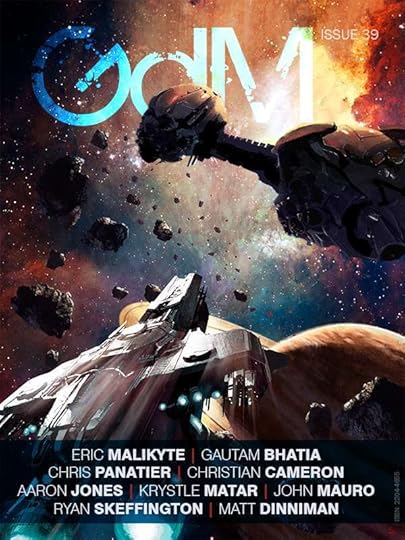
We have ab epic line up for you once again, so come get your teeth into some of the dark stuff!
FICTIONDead Reckoning II by Christian CameronWaiting for Witnesses by Gautam BhatiaThe Skin of Aquila Cadens by Chris PanatierObserver by Eric MalikyteNON-FICTIONGrimdark is a State of Mind by Krystle MatarAn Interview with Ryan Skeffington by John MauroReview: Lost Souls by Ryan Skeffington (John Mauro)The Quest for Transparent Aluminium: Materials Science in Science Fiction by John MauroReview: The Mercy of Gods by S.A. Corey (Adrian Collins)An Interview with Matt Dinniman by Beth TablerReview: Dungeon Crawler Carl by Matt Dinniman (Beth Tabler)Science Fiction and The Dark Side of the Future by Aaron S. JonesRead Grimdark Magazine Issue #39The post Grimdark Magazine Issue #39 out now! appeared first on Grimdark Magazine.



